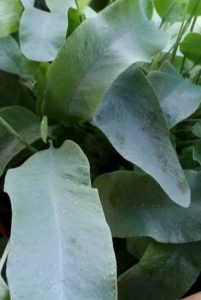Let us get to know about a low-maintenance fern with tolerance towards low light? The Blue Star Fern has curly bluish-green leaves and a rhizomatous body structure. Surprisingly, the leaves don’t fall off on getting old but turn into finger-like branched growths.
The Phlebodium fern is a native of tropical and subtropical forests of America. The natural habitat of this epiphytic climber is growing under the dense trees in forests. Thus, the plant grows with minimum sunlight, making it suitable for a variety of sunlight levels.
For beginners or experienced fern lovers, this bluish fern is a nice choice to make hanging baskets and table pots. In this article, we are going to share a detailed guide about the Phlebodium Blue Star Plant along with its care and propagation.
Blue Star Fern Classification
Family: Polypodiaceae
Genus: Phlebodium
Species: P. aureum
Common Names of Blue Star Fern
- Golden Polypody.
- Polypodium aureum.
Blue Star Fern Plant Features

Height and Length of Blue Star Fern
The height of a mature plant remains around 60 inches.
Long leaves join at the base to form a shrub-like body.
Leaves
The leaves make the length of the plant. Each mature curly leaf is between 15 to 50 inches long.
Rhizome
The Phlebodium aureum blue star plant develops and spreads through the underground creeping rhizome.
Air Purification
The Phlebodium air purifier with its bluish curly leaves removes the toxins from the air. Beauty with the benefits of clean and healthy air. Cool, isn’t it?
Growth Zone
The plant is hardy in zones 9 to 11. However, if you wish to grow them in cooler zones, make sure you don’t keep the plant outdoors on cooler days and maintain a suitable temperature.
Blue Star Fern Care
Let us have a look at the basic care and requirements of the phlebodium aureum blue star plant.
Water Requirement
This is a water-loving fern and loves moist soil. Water moderately and make sure the soil is fairly moist and the plant is never standing with water at the base. Thus, always avoid over-watering. It would be great if you water the soil from the sides and not above the foliage.
Sunlight Requirement
A bright indirect sunlight is ideal for the plant. However, being a natural dweller of shady under trees, this delicate peep can tolerate different levels of light including shade. To summarize, anything other than the direct scorching sun is fine for this fern.
Choose any spot like an indirectly well-lit window or some shady indoor corner. Avoid direct sunlight as this may burn the delicate foliage.
Soil Requirement
Use any well-drained soil with large particles. The natural soil of your zone shows good results for the fern. In addition, a mixture of perlite and peat moss in equal proportion is a nice potting mix as well.
Humidity Requirement
Ferns are known as humidity lovers. About 70% moisture in the air is a nice suitable moisture level. In dry days you, consider using a pebble-water tray under the pot or a humidifier in the surrounding.
Temperature Requirement
A temperature range of 50 to 80 F is ideal for the fern. These plants are not much hardy for winter and frost. Thus, make sure you transfer the outdoor peeps indoor in fall and winter.
Fertilizer Requirement
Ferns are in general not heavy eaters. They don’t crave added nutrition and extra fertilizers. A diluted dose of common houseplant fertilizer is enough for two to three times the dose in the growing season. Be careful guys! Overfeeding may burn this “diet cautious peep”!
Pruning Requirement
The plants in hanging baskets and small pots need size maintenance. Thus, you may remove some of the leaves from the lower side to control the size. This will also show good results for the overall outlook and health of the plant.
Blue Star Fern Propagation
Popular methods of propagation include:
- Spores.
- Division of Rhizome.
The spores usually take a long time and strict conditions to grow. So, the commonly used method is a division of rhizome.
Season
Spring and summer are the ideal days to propagate the phlebodium plant.
Method
- First of all, you need a well-grown parent plant. Now, take it out of the soil gently.
- Use a sharp knife and cut about 1/3rd of the rhizome.
- Plant the parent in its original place or the new pot if you wish to repot.
- Now, plant the baby rhizome in moist well-grown soil or the suitable potting mix.
- Keep the setup at a warm and moist place with indirect light of low to medium intensity. What the soil mildly every third to the fourth day to keep the soil moist.
Timeline
Day 1 to Day 30: The initial care of phlebodium fern includes warmth, humidity, moderate indirect light, and mildly moist soil.
The baby rhizome will take about three weeks to settle as an individual plant body. New leaves will grow out around the fourth week.
Day 30 onwards: Just follow the Blue Star Fern Care shared in the previous section and enjoy the growth of the bluish-green fronds.
Summary
The Blue Star Fern is an easy-to-grow fern with tolerance towards different light levels. The bluish-gray fronds of the plant get an elongated form instead of falling out on getting old. The phlebodium Blue Star Care includes moist well-drained soil and indirect light. This epiphytic fern is a nice selection to make hanging baskets and pots. You can grow them both indoors and outdoors. However, don’t forget to transfer them to warm spots in fall and winter.

